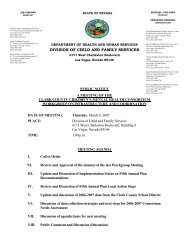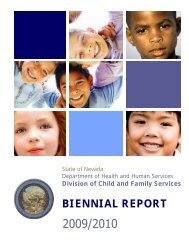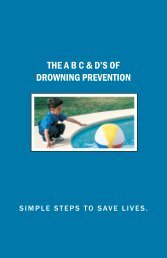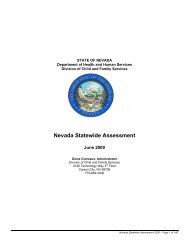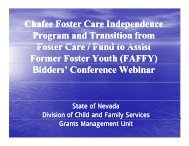STATE OF NEVADA - Division of Child and Family Services
STATE OF NEVADA - Division of Child and Family Services
STATE OF NEVADA - Division of Child and Family Services
Create successful ePaper yourself
Turn your PDF publications into a flip-book with our unique Google optimized e-Paper software.
Item 45: State use <strong>of</strong> cross-jurisdictional resources for permanent placements<br />
Goal: The State will ensure a process is in place for the effective use <strong>of</strong> cross-jurisdictional resources to facilitate timely<br />
adoptive or permanent placements for waiting children.<br />
There are several objectives under this item that the State is in the process <strong>of</strong> addressing as part <strong>of</strong> the five year process.<br />
The first objective is under development. In this objective, the State will be working on a process to provide stakeholders<br />
with an opportunity to provide input on the child welfare system <strong>and</strong> ICPC foster <strong>and</strong> adoptive parent recruitment <strong>and</strong><br />
retention. In regards to recruitment, The State continues to use a variety <strong>of</strong> cross-jurisdictional resources to facilitate<br />
timely adoptive <strong>and</strong> permanent placement for waiting children, including national media, adoption exchanges, photo<br />
listings, <strong>and</strong> the Interstate Compact on the Placement <strong>of</strong> <strong>Child</strong>ren (ICPC).<br />
In April 2010, the Nevada Deputy Compact Administrator attended the annual convention <strong>of</strong> the Association <strong>of</strong><br />
Administrators <strong>of</strong> the Interstate Compact on the Placement <strong>of</strong> <strong>Child</strong>ren (AAICPC). The purpose <strong>of</strong> this convention was to<br />
discuss <strong>and</strong> vote on changes as necessary on regulations applicable to the Compact, as well as, share information<br />
among member states. This year, as significant amount <strong>of</strong> time was devoted to the new Compact, regarding the changes<br />
<strong>and</strong> the impact <strong>of</strong> these changes on the ICPC process. Currently, 11 states have passed legislation to replace the former<br />
compact with the new one. It is anticipated that the majority <strong>of</strong> states will follow as there respective legislative sessions<br />
take place. Nevada is considering a bill for the 2011 Legislative session.<br />
During the past year, the State ICPC Unit has been conducting ICPC Partner meetings each month. These meetings<br />
include representatives from the State ICPC Unit at DCFS, DCFS – IMS, WCDSS ICPC staff, CCDFS ICPC staff <strong>and</strong><br />
DCFS – Rural Region ICPC staff. The goal <strong>of</strong> these meetings is to promote collaboration, <strong>and</strong> to discuss <strong>and</strong> resolve<br />
important ICPC issues. This has resulted in the effective use <strong>of</strong> cross-jurisdictional resources that facilitate timely<br />
adoptive <strong>and</strong> permanent placements for waiting children.<br />
A second objective is that the State will complete the electronic process for the data collection, monitoring <strong>and</strong> reporting<br />
out on effectiveness <strong>of</strong> achieving timely home studies <strong>and</strong> other ICPC Compact Requirements. The State ICPC Unit<br />
continues to provide 24 hour internal processing time for incoming <strong>and</strong> outgoing referrals. Currently 27 states accept<br />
referrals electronically, greatly reducing transit time <strong>and</strong> increasing the time for receiving states to complete home studies<br />
within the 60 day required time frame. The State ICPC Unit continues to utilize an email box developed for ICPC inquires,<br />
status checks, <strong>and</strong>/or requests for additional information. This has allowed a quicker turn around time for caseworkers<br />
requiring immediate information on new referrals, home study completions, approvals, denials, status updates, placement<br />
dates for case planning purposes <strong>and</strong>/or court proceedings, as well as providing a mechanism to expedite communication<br />
to other states. Also, the State ICPC Unit continues to work with IMS on improvements <strong>of</strong> the electronic processing <strong>of</strong><br />
cases. UNITY screens were developed in the previous year which allows the processing <strong>of</strong> new referrals, approvals <strong>and</strong><br />
denials. These screens have streamlined the process <strong>and</strong> provided greater accuracy, accountability <strong>and</strong> success in<br />
meeting ASFA timelines. The addition <strong>of</strong> UNITY screens relating to ICPC has enabled the State to develop data reports<br />
for analysis <strong>and</strong> identification <strong>of</strong> trends <strong>and</strong> potential issues requiring training. By July 2010, the final rollout <strong>of</strong> the home<br />
Study Report is anticipated. This report will capture data relating to how many home studies have been requested by<br />
each agency, how many are past due <strong>and</strong> how far they are past due. This will allow the State ICPC Unit to identify states<br />
or counties who may have a consistent problem with returning home studies, providing an opportunity for contact <strong>and</strong><br />
collaboration as appropriate. The report will also assist in maintaining numbers for workforce development <strong>and</strong> analysis.<br />
Current reports the State ICPC Unit collects internally are able to provide the State with a variety <strong>of</strong> important data points.<br />
For example, the State has seen a slight increase in the number <strong>of</strong> outgoing referrals <strong>and</strong> a slight decrease in incoming<br />
referrals in the past year as shown in Figure 18. For outgoing referrals, Clark County had a slight drop, while Washoe<br />
County <strong>and</strong> the DCFS – Rural Region showed a slight increase. Incoming referrals are also showing a slight increase<br />
overall for all agencies, however, there was a small drop in the second quarter.<br />
Nevada APSR – SFY 2010<br />
Page 83 <strong>of</strong> 108



